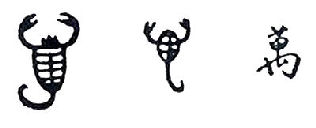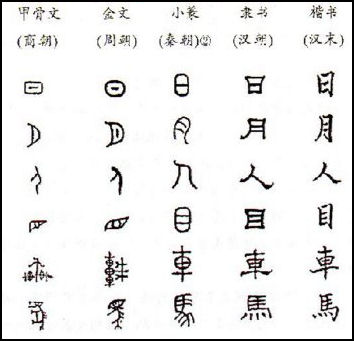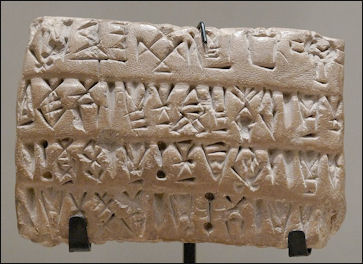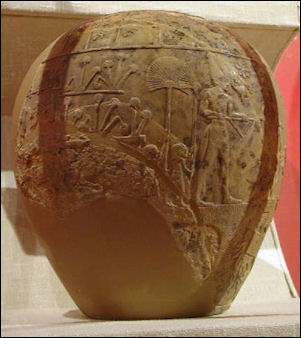EARLY CHINESE SPOKEN AND WRITTEN AND LANGUAGES
 Linguists have determined the early inhabitants of northern China spoke a language similar to Tibetan, while those in southern China spoke Miao-Tao, Austroasiatic and Tai-Kadai languages similar to the languages spoken today in Thailand, Myanmar, Laos, Cambodia, Vietnam and peninsular Malaysia.
Linguists have determined the early inhabitants of northern China spoke a language similar to Tibetan, while those in southern China spoke Miao-Tao, Austroasiatic and Tai-Kadai languages similar to the languages spoken today in Thailand, Myanmar, Laos, Cambodia, Vietnam and peninsular Malaysia.
Chinese written characters began as little pictures representing objects. Later representations of abstract thoughts appeared and later still they were modified into phonetic characters. As time went on the characters themselves became more simplified and abstract so that today they are now symbols and bear little resemblance to the original objects they represented.
Markings that may be writing have been found on objects dated to 7000 B.C. at the Jiahu neolthic site. Unusual black markings on pottery produced by the Dadiwans—a stone-age culture that resided in what is now Gansu Province beginning at least 5000 B.C. are regarded by some archeologist as primitive pictographic characters.
The first examples of what are universally recognized as Chinese characters—inscriptions on oracle bones and bronze vessels—were produced during the Shang Dynasty (1766-1122 B.C.) See Oracle Bones, Shang Dynasty
Some 2000 different characters were already in use in the Shang dynasty (1700-1100 B.C.). Some of the earliest writing was done on perishable bamboo and wood. Much of this has been lost to time.
RELATED ARTICLES IN THIS WEBSITE: PREHISTORIC AND SHANG-ERA CHINA factsanddetails.com; ANCIENT FOOD, DRINK AND CANNABIS IN CHINA factsanddetails.com; NEOLITHIC CHINA factsanddetails.com; JIAHU (7000-5700 B.C.): CHINA’S EARLIEST CULTURE AND SETTLEMENTS factsanddetails.com; JIAHU (7000 B.C. to 5700 B.C.): HOME OF THE WORLD’S OLDEST WINE AND SOME OF THE WORLD’S OLDEST FLUTES, WRITING, POTTERY AND ANIMAL SACRIFICES factsanddetails.com; YANGSHAO CULTURE (5000 B.C. to 3000 B.C.) factsanddetails.com; HONGSHAN CULTURE AND OTHER NEOLITHIC CULTURES IN NORTHEAST CHINA factsanddetails.com; NEOLITHIC TIBET, YUNNAN AND MONGOLIA factsanddetails.com
RECOMMENDED BOOKS: “Oracle Bones: A Journey Through Time in China” by Peter Hessler Amazon.com ; “A Companion to Chinese Archaeology” by Anne P. Underhill Amazon.com; “The Archaeology of Ancient China” by Kwang-chih Chang Amazon.com; “New Perspectives on China’s Past: Chinese Archaeology in the Twentieth Century,” edited by Xiaoneng Yang Amazon.com; “The Origins of Chinese Civilization" edited by David N. Keightley Amazon.com; “Liangzhu Culture” by Bin Liu, Ling Qin, et al. Amazon.com; “Hongshan Jade: The oldest, most imaginative jades full of mysterious beauty” Kako Crisci Amazon.com ; “Qijia (Jades of the Qijia and related northwestern cultures of early China, ca. 2100-1600 BCE” by Dr. Elizabeth Childs-Johnson and Gu Fang Amazon.com ; “The Story of Rice” by Xiaorong Zhang Amazon.com
Inscribed Symbols from Jiahu
Jiahu is a rich but little known archeological site located near the village of Jiahu near the Yellow River in Henan Province in central China. About equidistant between Xian and Nanjing, the site was occupied from 9,000 to 7,800 years ago. Zhang Juzhong and Cui Qilong wrote in “A Companion to Chinese Archaeology”: An “important discovery at Jiahu is the inscribed symbols on artifacts. We found 17 groups of inscribed symbols on turtleshell, stone, bone, and pottery. Different symbols appeared on different kinds of objects. Were these the earliest Chinese characters, and what meaning did they have? We found that there were nine incised symbols on tortoise shells, five on bone tools and three on pottery vessels. [Source: “The Jiahu Site in the Huai River Area” by Zhang Juzhong and Cui Qilong, A Companion to Chinese Archaeology, edited by Anne P. Underhill, Blackwell Publishing Ltd., 2013 thirdworld.nl ~|~]
Among the objects in burials, only one has an incised symbol. It appears on a stone tool “shaped like the end of a sword handle” (" bingxing shishi") and was buried with an aged female (see Henan 1999 : 973–975). Most of the skeletons in burials with inscribed turtleshells and bone tools were male. Other stone tools and pottery vessels with inscriptions were discovered inside houses and in pits. ~|~
“The Jiahu inscriptions are important because they shake the deep-rooted assumption made by many that pictographs on pottery from Neolithic cultures such as Dawenkou represent the origin of Chinese characters. The oracle bone inscriptions from Yinxu, the late Shang site at Anyang, is a fully developed writing system, and the Jiahu symbols are helpful for understanding the origins of that script. There are some strong similarities. First, both types of incised marks were made by the same kind of sharp tool, and they were made on bone, including on turtleshells. Second, the purpose of the oracle bone script from Yinxu was to document the results of divination. The Jiahu incised symbols must also have had some kind of relationship with divination. Therefore we believe that the incised symbols invented by the Jiahu people more than 8,000 years ago have some kind of relationship with the origins of the Shang oracle bone script and therefore could be relevant to the origin of Chinese characters.” ~|~

Evolution of Chinese characters
Signs on 8,600-Year-Old Chinese Tortoise Shells: World’s Earliest Writing?
Signs carved into 8,600-year-old tortoise shells found in Jiahu, China may be the earliest written words, say archaeologists. The BBC reported: “They predate the earliest recorded writings from Mesopotamia – in what is now Iraq – by more than 2,000 years. The archaeologists say they bear similarities to written characters used thousands of years later during the Shang dynasty, which lasted from 1700-1100 B.C.. But the discovery has already generated controversy, with one leading researcher in the field branding it “an anomaly”. [Source: Paul Rincon, BBC Science, April 17, 2003. The research was published in the journal Antiquity. =/=]
“The archaeologists have identified 11 separate symbols inscribed on the tortoise shells. The shells were found buried with human remains in 24 Neolithic graves unearthed at Jiahu in Henan province, western China. The site has been radiocarbon dated to between 6,600 and 6,200 B.C.. The research was carried out by Dr Garman Harbottle, of the Brookhaven National Laboratory in New York, US, and a team of archaeologists at the University of Science and Technology of China, in Anhui province. “What [the markings] appear to show are meaningful signs that have a correspondence with ancient Chinese writing,” said Dr Harbottle. =/=
“The Neolithic markings include symbols that resemble the characters for “eye” and “window” and the numerals eight and 20 in the Shang script. “If you pick up a bottle with a skull and crossbones on it, you know instantly that it’s poison without the word being spelt out. We’re used to signs that convey concepts and I wouldn’t be surprised if that’s what we’re seeing here,” Dr Harbottle told BBC News Online. =/=
“However, Professor David Keightley, of the University of California, Berkeley, US, urged caution, particularly over the proposed link to the much later Shang script. “There is a gap of about 5,000 years [between them]. It seems astonishing that they would be connected,” he said. He added that the link had to be proved more thoroughly. But Dr Harbottle points to the persistence of sign use at different sites along the Yellow River throughout the Neolithic and up to the Shang period, when a complex writing system appears.He emphasised that he was not suggesting the Neolithic symbols had the same meanings as Shang characters they resembled. Professor Keightley added: “It’s a puzzle and an anomaly; [the symbols] are remarkably early. We can’t call it writing until we have more evidence.” He noted that there were indications the Neolithic culture at Jiahu may not have been complex enough to require a writing system. =/=
“But Professor Keightley did say the signs appeared to be highly “schematised” or stylised. This is a feature of Chinese written characters. Aggregations of small pebbles were found close to several of the tortoise shells. The Jiahu researchers propose that the shells once contained the pebbles and were used as musical rattles in shamanistic rituals. In one grave, eight sets of tortoise shells were placed above the skeletal remains of a man whose head was missing. The shells come from graves where, in 1999, the researchers unearthed ancient bone flutes. These flutes are the earliest musical instruments known to date.
8000-Year-Old Pictographs on a Cliff: the World’s Oldest Writing?

Eleven characters found at Dingging in Shandong
In May 2007, Chinese archaeologists announced that they had found more than 2,000 pictographs dating back 7,000 to 8,000 years, about 3,000 years before other texts, which they claimed were progenitors of modern Chinese characters. Xinhua reported: “The pictographs are on rock carvings in Damaidi, at Beishan Mountain in northwest China's Ningxia Hui Autonomous Region, which covers about 450 square kilometers with more than 10,000 prehistoric rock carvings. Paleographers claim that the pictographs may take the history of Chinese characters back to 7,000 to 8,000 years ago. [Source: Xinhua, May 18, 2007 ~]
“Paleographers claim that the pictographs may take the history of Chinese characters back to 7,000 to 8,000 years ago. "We have found some symbols shaped like both pictures and characters," said Li Xiangshi, a cliff-carving expert at the North University of Nationalities based in Yinchuan, capital of Ningxia. "The pictographs are similar to the ancient hieroglyphs of Chinese characters and many can be identified as ancient characters." ~
The Damaidi carvings, first discovered in the late 1980s, cover 15 square kilometers with 3,172 cliff carvings, featuring 8,453 individual figures such as the sun, moon, stars, gods and scenes of hunting or grazing. "Through arduous research, we have found that some pictographs are commonly seen in up to hundreds of pictures in the carvings," said Liu Jingyun, an expert on ancient Oracle Bone characters. "The size, shape and meanings of the pictographs in different carvings are the same," Liu said. Liu believed the meanings of all the pictographs could be deciphered on the basis of certain classifications such as gender.” ~
The Damaidi petroglyphs feature 8,453 individual figures. Damaidi itself is a small village located in Zhongwei in Central China, set amid the Weining Mountains on the north bend of the Yellow River. The carvings at Damaidi, which date back 7,000-8,000 years, feature environmental as well as social themes. There are carvings of the sun and moon along with other celestial bodies as well as of people hunting, herding and fighting. Archaeologists believe that some of these symbols (over 1,500) bear a resemblance to ancient hieroglyphs of Chinese characters. [Source: Wikipedia]
5,000-Year-Old Writing” Discovered in China

Shang Era writing from an oracle bone
In July 2013, Chinese archaeologists announced they had discovered a new form of primitive writing in markings on stoneware excavated from the relic site in eastern China dating 5,000 years back, about 1,400 years earlier than the oldest known written Chinese language. The stoneware—a piece of a stone ax and the “Zhuangqiao grave relic”—were found in Pinghu, in eastern China's Zhejiang province. The inscriptions predate the oracles, writings on turtle shells dating back to the Shang Dynasty (C.1600-1046 B.C.), which are commonly believed to be the origin of the written Chinese language system. [Source: Associated Press, July 11, 2013 ]
Associated Press reported: “Archaeologists say they have discovered some of the world's oldest known primitive writing, dating back 5,000 years, in eastern China, and some of the markings etched on broken axes resemble a modern Chinese character. The inscriptions on artifacts found south of Shanghai are about 1,400 years older than the oldest written Chinese language. Chinese scholars are divided over whether the markings are words or something simpler, but they say the finding will shed light on the origins of Chinese language and culture. The oldest writing in the world is believed to be from Mesopotamia, dating back slightly more than 5,000 years. Chinese characters are believed to have been developed independently.
“Inscriptions were found on more than 200 pieces dug out from the Neolithic-era Liangzhu relic site. The pieces are among thousands of fragments of ceramic, stone, jade, wood, ivory and bone excavated from the site between 2003 and 2006, lead archaeologist Xu Xinmin said. The inscriptions have not been reviewed by experts outside the country, but a group of Chinese scholars on archaeology and ancient writing met last weekend in Zhejiang province to discuss the finding. They agreed that the inscriptions are not enough to indicate a developed writing system, but Xu said they include evidence of words on two broken stone-ax pieces. One of the pieces has six word-like shapes strung together to resemble a short sentence. "They are different from the symbols we have seen in the past on artifacts," Xu said. "The shapes and the fact that they are in a sentence-like pattern indicate they are expressions of some meaning."
“The six characters are arranged in a line, and three of them resemble the modern Chinese character for human beings. Each shape has two to five strokes. "If five to six of them are strung together like a sentence, they are no longer symbols but words," said Cao Jinyan, a scholar on ancient writing at Hangzhou-based Zhejiang University. He said the markings should be considered hieroglyphics. He said there are also stand-alone shapes with more strokes. "If you look at the composition, you will see they are more than symbols," Cao said.
“But archaeologist Liu Zhao from Shanghai-based Fudan University warned that there was not sufficient material for any conclusion. "I don't think they should be considered writing by the strictest definition," Liu said. "We do not have enough material to pin down the stage of those markings in the history of ancient writings." For now, the Chinese scholars have agreed to call it primitive writing, a vague term that suggests the Liangzhu markings are somewhere between symbols and words."
Debate Over the “5,000-Year-Old Writing” Discovered in China
A day after the discovery of the “5,000-year-old writing was announced, AFP reported: “Fierce debate has erupted among experts in China over the discovery of 5,000-year-old inscriptions that some believe represent the earliest record of Chinese characters. Pottery pieces and stone vessels unearthed at the Zhuangqiaofen archaeological site in the eastern province of Zhejiang push "the origin of the written language back 1,000 years", the state-run Global Times newspaper reported. [Source: AFP |^|]
“Li Boqian, an archaeology professor from Peking University, said the symbols reveal the ancient Liangzhu civilisation — which existed in Zhejiang and neighbouring Jiangsu in the Neolithic Age — had already developed the basic structure of sentences from independent words, the Global Times said earlier this week. Other specialists dismissed the significance of such a find. Xu Hong, an archaeology researcher from the Chinese Academy of Social Sciences, expressed scepticism on links between the inscriptions and the development of Chinese script. "Even if those signs on the stones were characters, they were simply from a long dead east Asian country before the Middle Kingdom existed," he said on Sina Weibo, China's version of the social network Twitter. "Many signs and character lookalikes earlier than the oracles have been found in east Asia." |^|
“Xia Jingchun, a professor of Chinese language from Beijing Technology and Business University, also wrote on Weibo: "It's long been believed by experts that there were more ancient characters than the oracles, because the oracles were too mature, and older languages are supposed to be less developed." The inscriptions were found among artefacts unearthed between 2003 and 2006, state media said. |^|
World’s Oldest Recognized Writing: 5,200-Year-Old Cuneiform Tablets from Mesopotamia

early Mesopotamian writing Cuneiform, the script language of ancient Sumer in Mesopotamia, consists of small, repetitive impressed characters that look more like wedge-shape footprints than what we recognize as writing. A Sumerian clay tablet from around 3200 B.C. inscribed in wedgelike cuneiform with a list of professions “is among the earliest examples of writings that we know of so far," according to the University of Chicago's Oriental Institute’ director, Gil J. Stein. [Source: Geraldine Fabrikant. New York Times, October 19, 2010]
Cuneiform (Latin for "wedge shaped") appears on baked clay or mud tablets that range in color from bone white to chocolate to charcoal. Inscriptions were also made on pots and bricks. Each cuneiform sign consists of one or more wedge-shaped impressions that are made with three basic marks: a triangle, a line or curbed lines made with dashes. Clay tablets with pictographs appeared around 4000 B.C. The earliest with Sumerian writing appeared around 3200 B.C. Around 2,500 B.C., Sumerian writing evolved into partial syllabic script capable of recording the vernacular.
Cuneiform symbols were made by scribes who used a stylus —with a triangular tip cut from reed — to make impressions on damp clay. The reeds could make straight lines and triangles but could not easily make curved lines. Different characters were made by superimposing identical triangles in different combinations. Complex characters had around 13 triangles. The moistened tablets were left to dry in the hot sun. After archaeologists excavate the tablets they are carefully cleaned and baked for preservation. The process is expensive and slow.
Many cuneiform tablets are dated by the year, month and day. Tablets from monarchs, ministers and other important people were impressed with their seal, which was applied on the wet clay like a paint roller with a cylinder seal. Some cylinder seals produced reliefs that were quite elaborate, made up of scores of images and markings. Important messages were encased in an "envelope" of more clay to insure privacy.
Cuneiform was used by speakers of 15 languages over 3,000 years. The Sumerians, Babylonians and Eblaites had large libraries of clay tablets. The Elbaites wrote in columns and used both sides of the tablets. The latest datable tablet, from Babylon, described the planetary positions for A.D. 74-75.
Book: The Story of Writing: Alphabets, Hieroglyphs & Pictograms by Andrew Robinson
World’s Oldest Writing: from Ancient Egypt?

scorpion mace
In 1995, John Coleman Darnell, a Yale Egyptologist, and his students discovered 18-x-20-inch tableau, dated to 3250 B.C., on a limestone cliff at a site called Gebel Tjauti, about 20 miles northwest of Luxor, that contains some line drawings of animals that are believed to be a record of the exploits of an Egyptian ruler. Because an image of a scorpion is present links to the Scorpion king were made. Some have even gone as far as calling the tableau “world's oldest historical record” and claim the images are early hieroglyphics and are examples of the world's oldest writing.
The tableau, probably incised with flint tools, has images of a scorpion, a falcon, large antelope, a bird, a serpent, a figure carrying a staff, a sedan chair, a bull's head, a captor and captive. No one knows what the images mean. The link to the Scorpion King are based on the fact that the scorpion is near the falcon and falcons in ancient Egypt were associated with the god Horus and the pharaohs.
The earliest Egyptian hieroglyphics are among the written languages that have not been deciphered. Others include are the Minoan language of Crete; the pre-Roman writing from the Iberian tribes of Spain; Sinaitic, believed to be a precursor of Hebrew; Futhark runes from Scandinavia; Elamite from Iran; Mohenjo-Dam, the language of the ancient Indus River culture; and Archaic Sumerian, the earliest written language in the world."
The world's oldest surviving personal name is a king represented by the hieroglyphic sign of a scorpion on a Upper Egypt tablet from 3,050 B.C. Some scholars have suggested that the king's name was Sekhen.
In the second millennium B.C. Semitic tribes converted Egyptian hieroglyphics into the first alphabet. Some graffiti with letters, dated to around 1800 B.C., found in southern Egypt, has been offered as evidence of the first alphabetic writing. The graffiti was dated based on nearby hieroglyphics and is theorized to have been made by an ancient Semitic people. What the symbols mean is not clear and whether there are indeed alphabetic letters is a matter of some debate. They predate other examples of alphabetic writing by two centuries.
Image Sources: Early characters, Nolls China website; Wikimedia Commons
Text Sources: Robert Eno, Indiana University /+/ ; Asia for Educators, Columbia University afe.easia.columbia.edu; University of Washington’s Visual Sourcebook of Chinese Civilization, depts.washington.edu/chinaciv /=\; National Palace Museum, Taipei \=/; Library of Congress; New York Times; Washington Post; Los Angeles Times; China National Tourist Office (CNTO); Xinhua; China.org; China Daily; Japan News; Times of London; National Geographic; The New Yorker; Time; Newsweek; Reuters; Associated Press; Lonely Planet Guides; Compton’s Encyclopedia; Smithsonian magazine; The Guardian; Yomiuri Shimbun; AFP; Wikipedia; BBC. Many sources are cited at the end of the facts for which they are used.
Last updated November 2016
